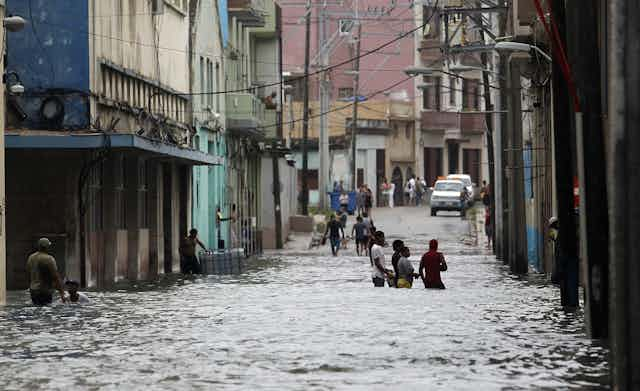We’re really only just learning about the impact Hurricane Irma has had on the Caribbean, especially for residents of disaster affected areas.
How can we tell their stories, and ensure their voices and experiences are not ignored? Here are four things the media could focus on:
1. Remember that locals get it worst
Local Caribbean residents are the real “losers”, not the tourists. They haven’t had a flight delayed, cancelled or temporarily inconvenienced by a hurricane. Instead, they have had their lives, livelihoods and homes devastated, and recovery will be a protracted process that will take many years.
The poorest and most marginalised populations across the region will be the most affected. Irma’s unequal impacts are starkly illustrated by looking at Richard Branson’s Necker island, which is part of the British Virgin Islands (BVI). Most of the buildings on Necker and other BVI islands were destroyed or badly damaged in the hurricane. Branson himself, however, was able to safely hunker down in his private cellar while Irma wreaked havoc.

2. Disasters are not “natural”
Location, or the severity of hazards, cannot sufficiently explain why Irma had such a severe impact. There needs to be an acknowledgement of why Caribbean nations are far more vulnerable to natural hazards than the US.
This requires a long hard look at the political and economic situation of these islands. For example, several reports have raised worries over the heavy reliance on a handful of sectors, such as agriculture and tourism, which will be severely impacted by Irma in the long-term. Countries with diverse economies are better able to recover following a disaster; but Caribbean countries will find recovery far more challenging, given their low economic diversity.
However, reports of destroyed hotels or ruined crops also conveniently ignore local history. As Leon Sealey-Huggins, an expert in Caribbean development based at the University of Warwick, points out, these economies were effectively forced to restructure economically towards these sectors, in light of a debt crisis that was largely due to their insertion into an unequal global system following independence. News reports should expose this side of the Caribbean’s colonial history, and add to the argument that Britain, France and the Netherlands, in particular, should be doing more to help.
3. Local civil society helps out
If coverage of previous large disasters is anything to go by, we are about to see an influx of images of distressed Caribbeans being saved, rescued and cared for by international relief organisations. However, it is important to stress that local civil society is often heavily involved. These may be formal, already established organisations, or they may be grassroots groups that form spontaneously in the wake of disaster.
Following Typhoon Haiyan, for instance, a huge cyclone that devastated the Philippines in 2015, two local NGOs, Coastal Core International and the Centre for Empowerment and Resource Development, were able to exploit their local knowledge and work effectively alongside the government. This sort of collaboration is crucial: local and international organisations mustn’t work in silos.

4. Media needs to have more sticking power
Too often, there is a media frenzy of physical destruction and human agony, and a focus on short-term relief operations. This will draw attention to the disaster, and likely galvanise many charity donations from overseas. However, it will also serve to turn the disaster into a spectacle – and the slow process of rebuilding roofs or clearing trees from roads isn’t much of a spectacle.
More attention must be given to long-term recovery. This is often forgotten about, and public engagement dries up. Granted, disaster recovery is not as “sexy” as response and relief. However, this phase is absolutely critical, and is an opportunity to recover society in a way that meets the needs of local people.


